
The Lencarta SuperFast Pro is an update of the Lencarta SF600 (respectively Godox QT400II and Godox QT600). For those of you not aware I reviewed the Lencarta SF600 a few years ago and was so impressed I bought a set of the heads for my studio. I’ve been very pleased with the SF600 heads so was very interested to get my hands on a SuperFast Pro head and see what’s changed, what’s better and what’s worse. The new features on the SuperFast Pro head are :-
One of my minor complaints with the SF600 was that the flash durations were not as fast at low power as some competitors. This was a deliberate design decision to keep the colour accuracy high at the expense of having slightly longer flash durations. Personally I think that was a good design decision. However with the SuperFast Pro you get the best of both worlds because there’s a colour accurate mode, which should give performance the same as the SF600s, and a speed mode for the ultimate in short flash durations at the sacrifice of colour accuracy. Inevitably the colour accuracy will suffer in the speed mode, it’ll be interesting to see how badly.
I will just make a couple of comments here about my experiences with the Lencarta SF600s. I have been very happy with these heads, they’ve allowed me to do things that I would not have otherwise been able to do. Such as taking action freezing photos as shown below, I’ve also made use of the fact that at lower powers you can shoot at 6 fps. They’ve been reliable and have a really nice, simple user interface.

Splash

Powder
| Lencarta SuperFast Pro | |
|---|---|
| 1 |  |
| 2 | 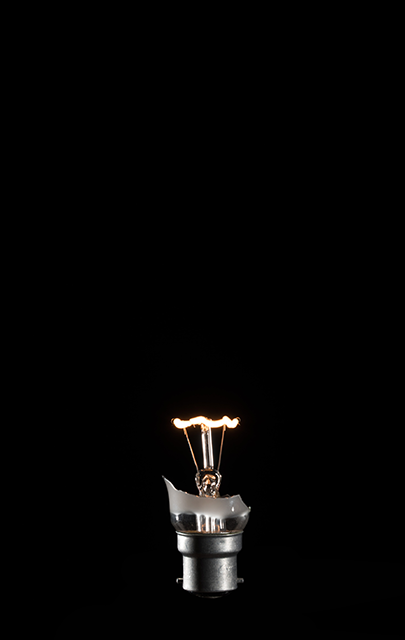 |
| 3 |  |
| 4 |  |
| 5 |  |
| 6 |  |
| 7 | 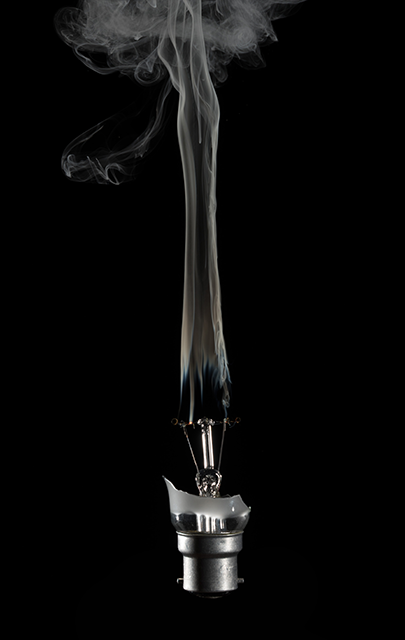 |
| 8 | 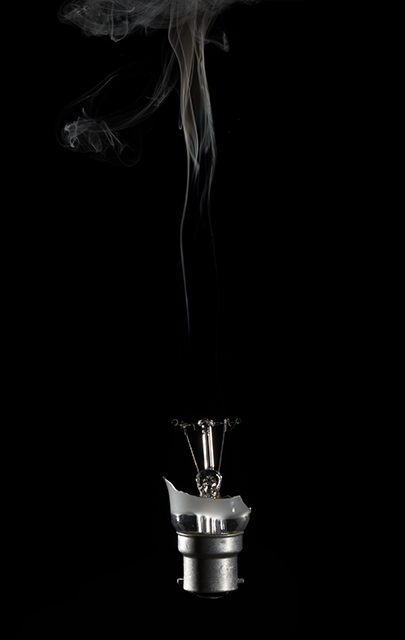 |
Note: This shows a high speed sequence taken with two heads at 6fps
About the only thing I don’t like is that the adjustment lever at the bottom of the head always has a very rough action to it, it sticks and then suddenly comes free. Not a big problem but not so nice to use either. But you have to admit that if that’s the only thing I can criticise about the SF600s then they’re extremely good heads.
Another minor issue is that I recently bought a Godox TT685N. One of the reasons I bought this hot shoe flash is because I expected it to work with the remote for the SF600s. It does not and nor will the SF600s trigger from the Godox X1N remote. Both of these things are fairly minor annoyances and not a major problem but it would be nice if there was a bit more cross functionality. Also, as far as I’m aware, Godox/Lencarta have still not produced a battery powered remote receiver that allows you to trigger any generic flash gun or flash head from the Lencarta remote transmitter. This is also a bit of a disappointment because it limits the extent to which you can use the SF heads with existing flash systems. What all of this shows is a slight lack of a coherent ecosystem, something that you would get with Bowens on Elinchrom. Saying that I think Lencarta/Godox are definitely getting there.

Side view of head
So, onwards and upwards. The SuperFast Pro is a 400J head and has a nominal guide number of 98m, which I’d say is a little generous as the SF600 is 600J and was only rated with a guide number of 75m. It has 7 stops of adjustment range, from full power (400J) to 1/128th power (3J). As I’ve said before I like heads with large adjustment ranges. One of the shortcomings of typical midrange Bowens 500J heads is that you can’t turn the power down far enough and that’s a problem for me.
The build quality of the head seem very good, it’s a heavy solid affair. I also noticed that the stickiness of the adjustment lever seems to have been solved so it’s very smooth in comparison the SF600.
The SuperFast Pro has an LCD display on the rear which has pretty good contrast and viewing angle. The contrast does start to drop a bit if you view it from below but generally it’s fairly good. There are several buttons on the rear. What’s not immediately apparent is that several of them have primary and secondary functions. The secondary function is accessed but pressing and holding the button down for a couple of seconds. It’s by pressing and holding the C.Fn button on the left of the rear panel that you turn off and on the fast/colour accurate mode.
It’s interesting that Lencarta have reverted to a more standard notation for the power level on this head. Full power is indicated by 1/1, half power is 1/2, quarter power is 1/4 and so on down to 1/128 being the lowest power and then if you decrement the power level another notch it goes to off. The off at the end of the power range is a useful thing because it means in a multi head setup you can turn heads off from the remote..
The controls on the head are slightly less intuitive than the SF600 as there are several more buttons, many of which have multiple functions associated with them. Because there’s a receiver built into the head there is a button GR/CH dedicated to setting the group and channel that the head is on. The Mode Button changes the flash head between 3 main modes: Manual, Stroboscopic and High Speed Sync (HSS). The C.Fn Button allows you to change the function settings of the flash head. A single press will turn the internal 2.4GHz receiver on/off. A long press will take you to the settings menu, where you can change the 4 function settings: Speed/Colour Mode (F1); Timer Function (F2); Mask Function (F3); Modelling Lamp Function (F4).
The S1/S2 Button controls the slave cell. A single press will enable S1, which activates the slave sell so that the flash head will fire whenever it sees another flash. A second press will enable S2, which activates the slave cell so that the flash head will fire when it sees every other flash - this is for use with hotshoe flashguns which use a pre-flash. A third press will disable the slave cell.
Fortunately there’s a dedicated button to turn the beep off with. There’s a test button and finally there’s the knob which allows you to change the output power level.
There’s also an external sync input socket so you can use a different wireless trigger system or wire the heads if you wish. I think the Lencarta triggers are so good, so cheap and allow direct control of all the key aspects of head it’s difficult to see why you’d want to do that unless you alredy have a trigger system that you want to stick with.
It's worth noting that the writing on the control panel is now white on a black background unlike the SF600s which were red on a black background which made them completely illegible in low light. So that's a definite step forwards.
The modelling light is a 150W E27 halogen screw fit bulb. There's still a clip on protective Pyrex cover over the flash tube and lower part of the modelling bulb. I suspect this is as much as anything to stop you getting a shock when changing modifiers as there are electrical contacts that are otherwise exposed. It's also a useful first line of defence for protecting the flash tube.
I will just make a comment here about the umbrella mount. There's a mount under neither the head which is part of the mounting bracket. This is not intended to be used. The actual umbrella mount that is intended to be used, and lines up with the hole in the reflector, is at the top of the head and is built into the body so you slide the umbrella shaft through the body of the flash head and it comes out the backside of the head. This isn't obvious and I went for a long while using the mount on the bottom of the head which is completely unsatisfactory. So be warned.
Here are a couple of photos so you can get an idea of the size and build quality of the head and also of the user interface.
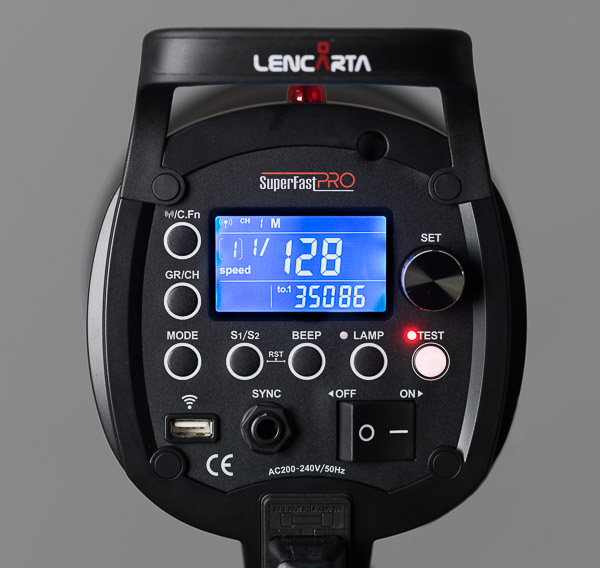
Close-up of the control panel

Front view showing the flash tube and modeling light
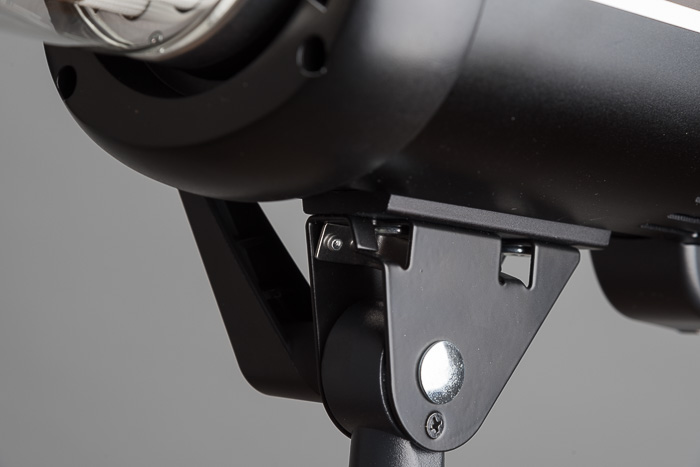
The stand based umbrella mount that is not intended to be used
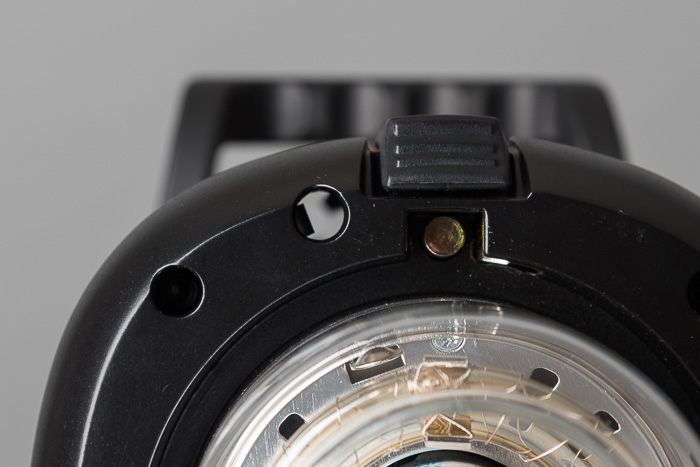
Front view showing the umbrella mount hole though the flash body
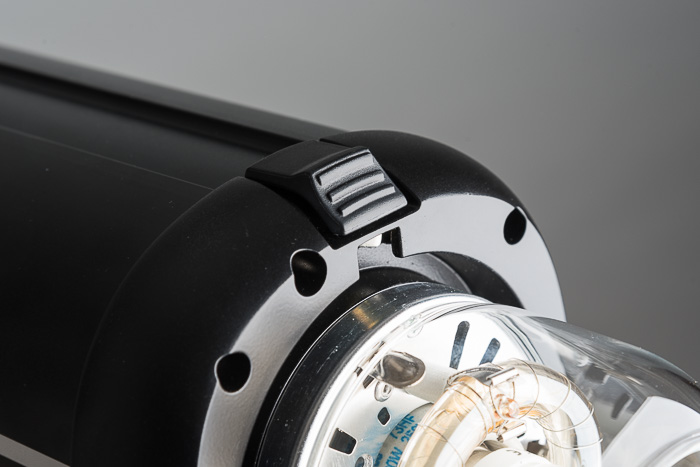
Front view showing the umbrella mount hole
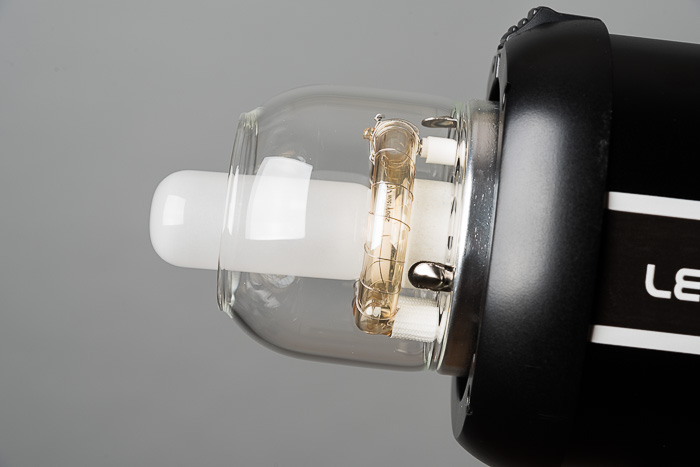
Front view showing Pyrex dome
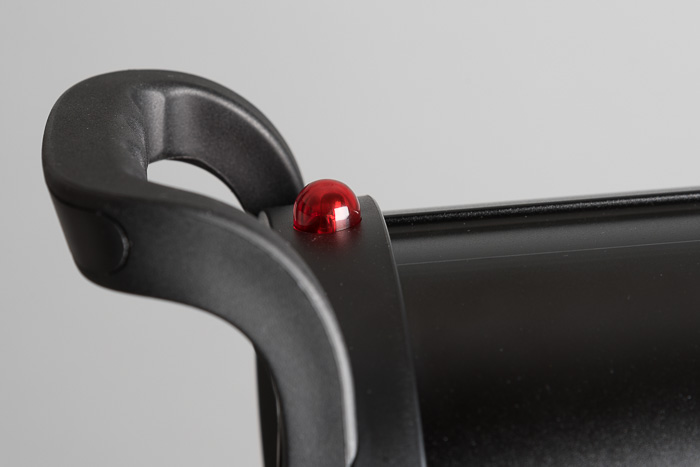
Rear view showing the optical slave receiver

WaveSync Transmitter

WaveSync Receiver
One of the things I really like about the SF600s is the remote trigger and in terms of functionality the new WaveSync remote is identical to the old remote which is really good news.
The remote has changed from the SF600 remote. The good news is the new SuperFast Pro receivers are compatible with the SF600 heads so you can trigger an SF600 head fitted with the new receivers from the new transmitter, you can also control power setting and modelling light or anything else on the SF600 with the new remote and receiver. However you do have to change the mode the transmitter is set to by holding the set button down for a couple of seconds so it changes from fractional power control to the old system of power setting 5 to 10. Also beware that there is also a third notational mode that you have to go through on the way which is power setting 1 to 6. I'm guessing this is to give compatibility with some other head with which I'm not familiar. The best option if you are using both SF600s and SuperFast Pro heads is to use the 5 to 10 notation mode as it works fine for both heads. Another excellent design decision is that the notational mode is remembered when you turn the remote off and back on so you don't have to reset it each time. But the main thing is that there is full backwards compatibility with the SF600s.
Another bit of good news is that the new WaveSync transmitter is compatible with the Godox TT685 so you can trigger those synchronously with your SF and SuperFast Pro heads. This is great news and shows that the whole system is evolving to have a broad level of compatibility. The receivers are £15 each and the transmitter is £25 or you can get a transmitter and receiver together for £35 so more than cheap enough to justify upgrading to. And that's something that I will probably do just to be able to trigger my Godox TT685N hot shoe flashgun synchronously with my SF600 heads.
Below is a table that shows how the various modes correlate with one another.
| SF Pro Setting | SF600/300 Setting | Other Setting |
|---|---|---|
| 1/1 | 10.0 | 6.0 |
| 1/2 | 9.0 | 5.0 |
| 1/4 | 8.0 | 4.0 |
| 1/8 | 7.0 | 3.0 |
| 1/16 | 6.5 | 2.5 |
| 1/32 | 6.0 | 2.0 |
| 1/64 | 5.5 | 1.5 |
| 1/128 | 5.0 | 1.0 |
So I think it's fair to say this is all slightly confusing but the main thing is it does give backwards compatability and I think that's very significant from the point of view of encouraging customer loyalty and also giving the end user a coherent ecosystem that they can become familiar with and grow into.
You can also trigger the SuperFast Pro head from the Godox X1N transmitter and you can alter the power level of the head too, frankly I wouldn't use it to control the power setting of the heads though unless you have to. Personally I find the user interface on the X1N to be very hard work, the WaveSync remote is so much easier to use. However at the moment you need to use the X1N if you want to use HSS on these heads with Nikon cameras. I believe the WaveSync remote does currently support HSS with Canon cameras though.
Firstly I measured power setting accuracy. This head behaves much as I expected, but better, based on the performance of previous IGBT designs that I’ve looked at. The quoted guide number is 98m at full power but because of the nature of IGBT switched heads the light output has a long tail on it at full power, as you can see if you look at the scope traces a bit further down the page. This means it can be a bit non-linear when it goes from full power to half power. That’s not the case here, the power is a little low at full power by my reckoning, I measured it at 79m rather than the quoted 98m. But I would not take that as gospel, I measure guide number with a standard reflector fitted at a distance of 2m on a mid grey background. Subtle things like the positioning of the flash tube in the head can affect the distribution of light over the target area, so although the light output may appear slightly low measured in this way it may not when measured differently. So what I’m saying is the power output of this head is close enough to be, in absolute terms, within the bounds measurement error.
| Power | Power Setting | Quoted GN | Actual GN | % of Quoted | Actual GN | % of Quoted |
|---|---|---|---|---|---|---|
| Colour Mode | Colour Mode | Speed Mode | Speed Mode | |||
| 400W | 1/1 | 98 | 79 | 80% | 79 | 80% |
| 200W | 1/2 | 69 | 54 | 77% | 54 | 77% |
| 100W | 1/4 | 49 | 39 | 79% | 39 | 79% |
| 50W | 1/8 | 35 | 28 | 80% | 24 | 68% |
| 25W | 1/16 | 25 | 19 | 79% | 17 | 70% |
| 13W | 1/32 | 17 | 13 | 78% | 13 | 78% |
| 6W | 1/64 | 12 | 9 | 70% | 10 | 79% |
| 3W | 1/128 | 9 | 6 | 69% | 7 | 79% |
The power delivery is very linear throughout the entire range in both colour accurate mode and speed mode. This is extremely good performance by any standards.
The next test I did was colour accuracy. Here I measured the head’s Kelvin white balance at output power settings from full power to minimum power. Typically IGBT designs have a tendency to give a bluer light as the power is reduced, unless the manufacturer compensates for this by reducing the supply voltage as the power is reduced, as done in the Paul C Buff Einsteins.
| Power | Power Setting | Kelvin White Balance | Kelvin White Balance |
|---|---|---|---|
| Colour Mode | Speed Mode | ||
| 400W | 1/1 | 4700 | 4650 |
| 200W | 1/2 | 4900 | 5000 |
| 100W | 1/4 | 4750 | 5300 |
| 50W | 1/8 | 5000 | 5950 |
| 25W | 1/16 | 4900 | 6950 |
| 13W | 1/32 | 4900 | 8150 |
| 6W | 1/64 | 4800 | 9100 |
| 3W | 1/128 | 4900 | 9100 |
The SuperFast Pro heads do exactly this (as did the SF600 heads) in colour accurate mode and they do it very well. The KWB in maintained to within 300K and that deviation is at full power. There is also a level of measurement uncertainty associated with this but I would guess that’s only in the region of 100K. So the performance in colour accurate mode is pretty good. What is interesting is that Lencarta have made to decision to put the nominal KWB figure for these heads at 5000K rather than 5600K that everyone else uses. This is a decidedly bad thing because it means if you use these heads in conjunction with any other heads you’ll have a 500k white balance difference between the SuperFast Pro heads and the other heads, even the SF600s! I guess for a lot of work you’ll not notice 500K of difference but for anything that involves colour accuracy, such as product photography, it would potentially be a problem.
Colour consistency in fast mode is a very different story. I varies wildly, from 4650K to 9100K! But then I expected it to and it's specified to, that’s the nature of the beast. I’ve seen a review of the Godox QT400II that makes a really big deal of this but I’m not convinced it is such a big deal. If you ever use these heads in fast mode then you’re after one thing and one thing only, ultra-fast flash durations. If that’s what you’re after then you’ll have to use the heads between 1/16th power and 1/128th power. Over this range there’s still a 2150K variation in white balance but the chances are you’d be shooting both heads at a similar power in which case you can correct for the white balance in post processing. So I think for those very few people who really need flash durations in excess of 1/5000th second these heads are still eminently usable.
Here I’m checking that when set to a given level the SuperFast Pro consistently delivers the same power. This is actually quite an important parameter as I have seen cheap heads that can vary by almost a stop, shot to shot which isn’t great. And indeed not so cheap heads like several of the Strobeam products that when used in burst mode give a decreasing amount of light as the burst of flashes goes on.
I tested this by firing a burst of 9 frames at 6fps at 1/8th power. The output power was consistent to within 1% over this burst so completely negligible variation for any real world situation. I also tried 3fps at quarter power and likewise the power delivery was completely consistent as was the colour. Overall excellent performance.
Flash duration is arguably one of the key attributes of the SuperFast Pro. And it basically does what it says on the tin. As you can see from the flash duration table below the heads are fast in colour accurate mode, from half power downwards they’re at least 1/2000th second (t=0.1) and at minimum power they’re slightly faster than 1/6000th second. This is very similar to the SF600s.
In speed mode they are indeed faster from 1/4 power downwards. At 1/4 power they’re already almost 1/5000th second and the Kelvin white balance hasn’t started to move off much at that point so you have a lot of power at a very short flash duration. Id say there aren’t many things that would require faster flash durations than this. If you do need to go faster the flash duration ends up at 1/20,000th second at minimum power. That’s probably similar to most hot shoe flash guns but delivering a bit more power. Even so a guide number of 7m is still pretty limiting for most things.
You can see what I’m talking about on the scope traces below. The amplitude of the pulse of flash light drops very substantially in colour accurate mode as the power is reduced, but the flash duration doesn’t change that much after the first 3 stops of adjustment. In speed mode the amplitude drops far less and the flash duration gets very short.
| Lencarta SuperFast Pro | |
|---|---|
| 400W | 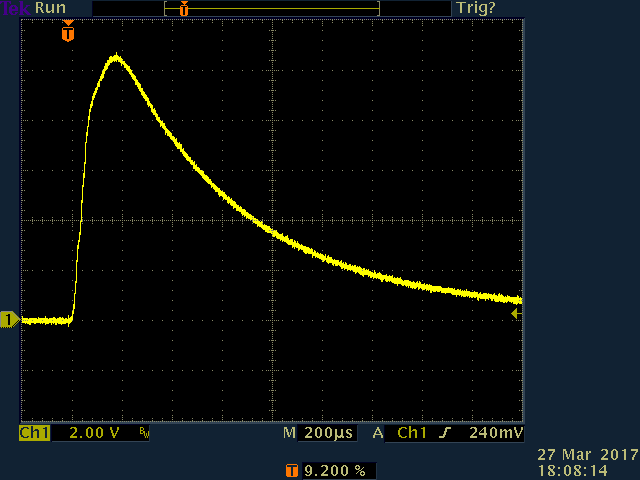 |
| 200W |  |
| 100W | 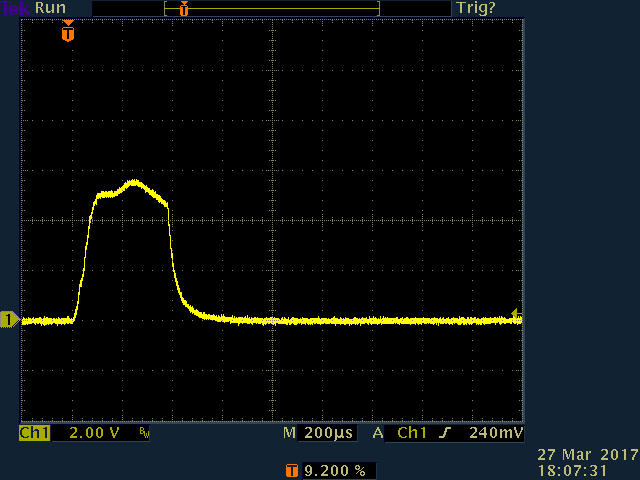 |
| 50W | 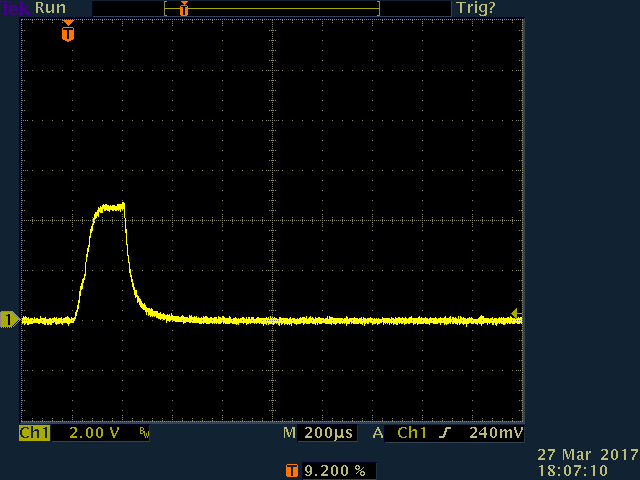 |
| 25W | 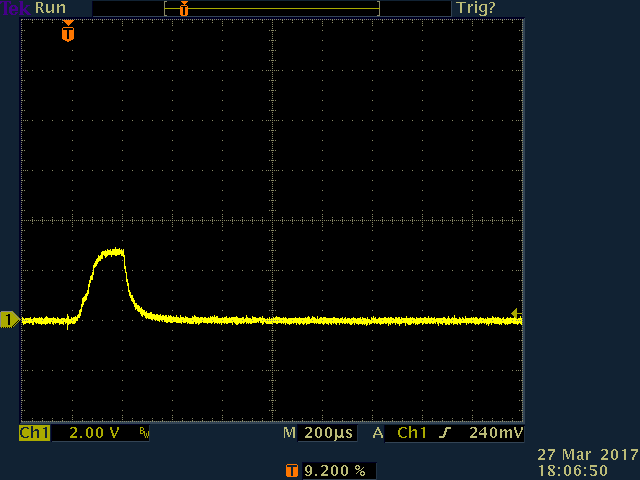 |
| 13W |  |
| 6W | 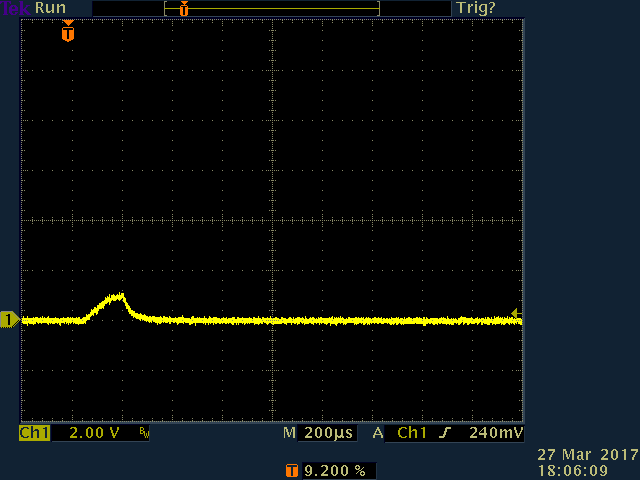 |
| 3W | 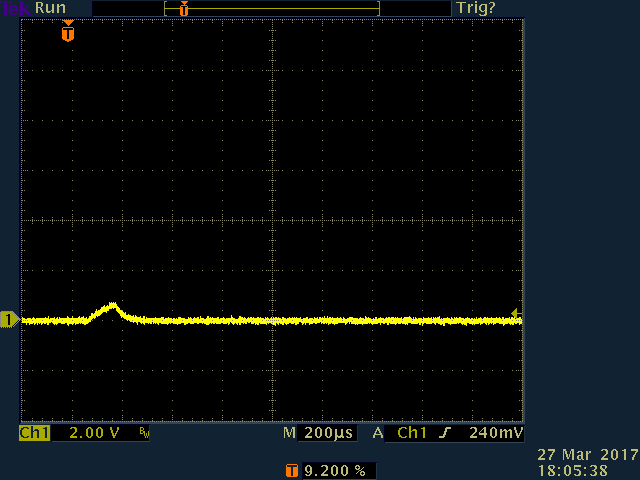 |
Note: Oscilloscope traces above show the variation in flash duration in colour accurate mode (rollover the power values to show the different scope traces)
| Lencarta SuperFast Pro | |
|---|---|
| 400W |  |
| 200W | 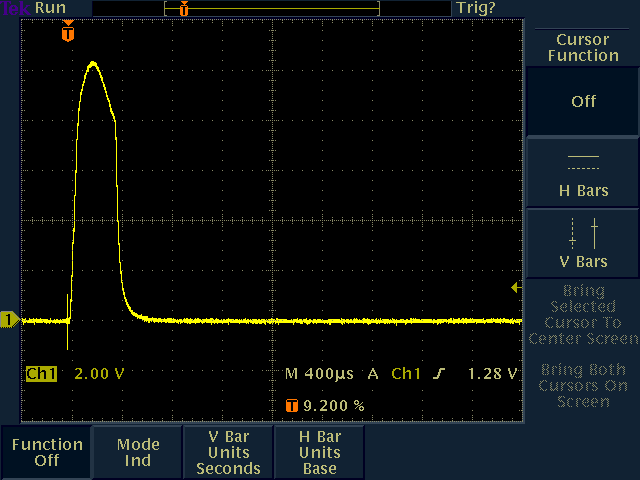 |
| 100W | 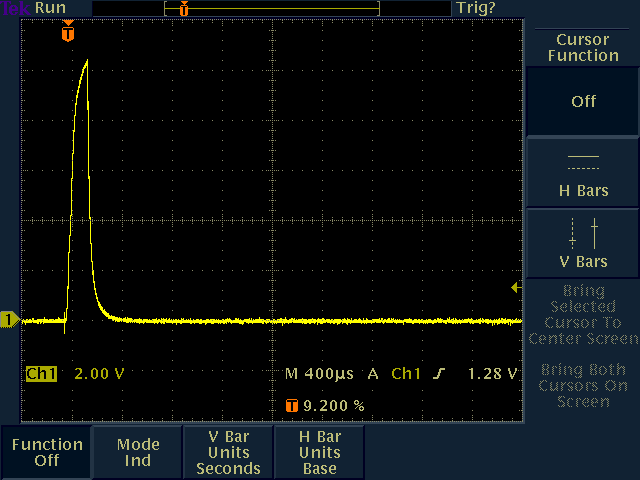 |
| 50W |  |
| 25W | 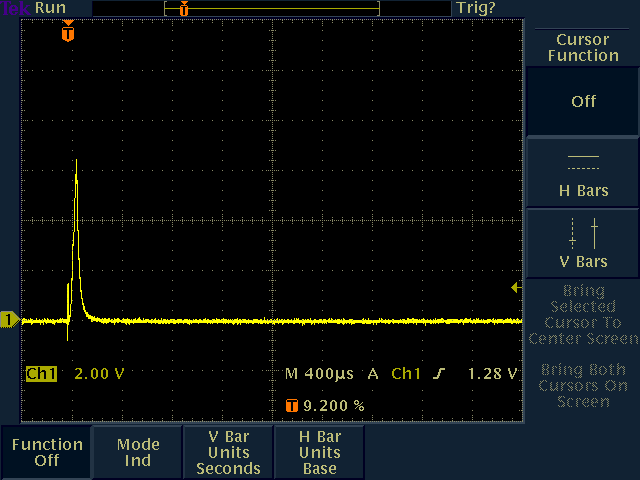 |
| 13W | 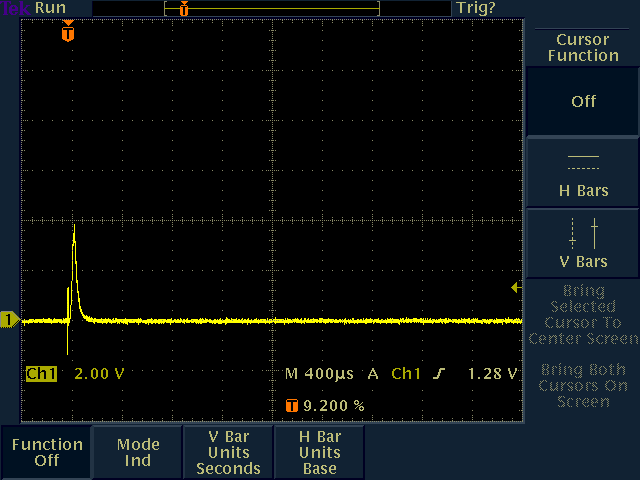 |
| 6W | 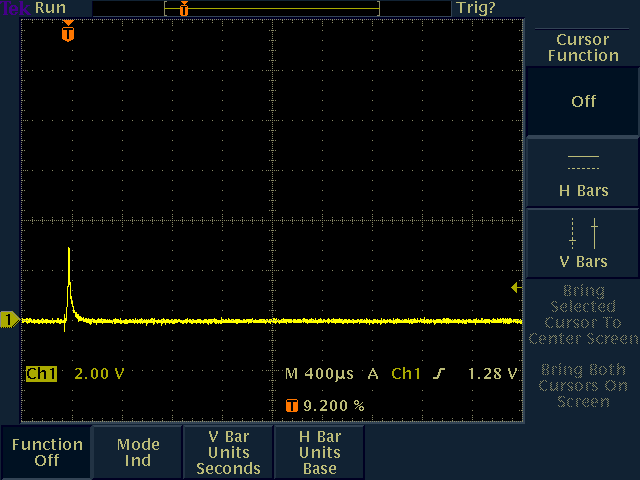 |
| 3W | 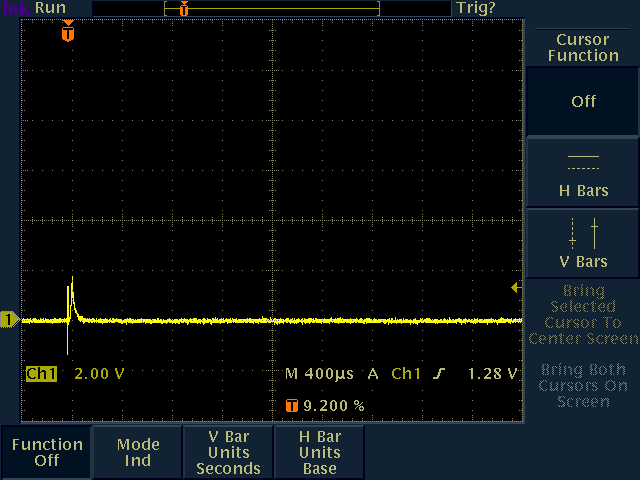 |
Note: Oscilloscope traces above show the variation in flash duration in speed mode (rollover the power values to show the different scope traces)
I’ve measured the SuperFast Pro head at 1 stop intervals from full power down to 1/128th power. I've noted t=0.1 times which is the time when output power has dropped to 10%. Most manufactures quote t=0.5, which is when the power has dropped to 50%. This is because it makes them look good and is the industry standard, even though it’s not terribly useful. t=0.1 is a more practical figure if you want to compare it to an equivalent shutter speed, at this point the light level is just over 3 stops down so what little light is still coming out of the flash is not going to show very much on your moving subject.
| Power | Power Setting | Speed Mode t = 0.1 | Colour Mode t = 0.1 |
|---|---|---|---|
| 400W | 1/1 | 1.600ms (1/625th) | 1.600ms (1/625th ) |
| 200W | 1/2 | 0.400ms (1/2,500th) | 0.500ms (1/2,000th) |
| 100W | 1/4 | 0.220ms (1/4,545th) | 0.464ms (1/2,155th) |
| 50W | 1/8 | 0.120ms (1/8,333th) | 0.264ms (1/3,788th) |
| 25W | 1/16 | 0.100ms (1/10,000th) | 0.240ms (1/4,167th) |
| 13W | 1/32 | 0.080ms (1/12,500th) | 0.228ms (1/4,386th) |
| 6W | 1/64 | 0.060ms (1/16,667th) | 0.188ms (1/5,319th) |
| 3W | 1/128 | 0.050ms (1/20,000th) | 0.152ms (1/6,579th) |
Note: The flash durations are shown in ms and in brackets as fractions of a second
So no longer do you have to compromise flash duration as with the SF600s. You can now make the choice of colour accuracy and flash durations that are in reality more than fast enough for 98% of photographers. Or if you really do need those ultra-fast flash durations you can have them at the expense of wildly varying colour balance.
I tried HSS with my Nikon D750 using the Godox X1N as the wireless trigger. It works but there’s a very substantial drop in output power from the SuperFast Pro, in fact I measured the guide number as 20m at full power shooting at 1/200th second! That’s such a huge reduction in power that I’d argue this mode gives you no benefit at all. At higher shutter speeds (1/1000 second upwards) there was a 1 stop less light at the bottom of the frame than at the top. This fade out to the bottom of the frame is not really a surprise as it’s quite a difficult thing to do, design wise, to keep the light output of a flash head constant over the duration it takes the shutter to move from the top of the frame to the bottom. I’ve seen heads that perform better in this respect though.
In summary though I’d have to say that for me the massive reduction in flash power when HSS mode is selected makes this a virtually useless feature of this head although I appreciate that if you have to shoot at a very wide aperture and therefore have to increase your shutter speed you may be able to make use of HSS mode but do not imagine you're going to over power the sun with it.
Multi mode gives multiple flashes for a single trigger so you can catch, say, a sports person moving through some sort of transition, hitting a tennis ball or whatever. I’m afraid a was clean out of sportsmen when I reviewed this head so I’ve shown a much more prosaic example of a ball being thrown against a black background but it does give you the general idea. The photo I’ve shown was taken with a 1 second exposure and 10 flashes at 1/128th power at 10Hz (10 flashes per second). The ball went out of the frame for the last 3 flashes.

Ball Parabolic Path
There is of course a compromise to be had between power setting, number of flashes and frequency of flash rate that can make juggling the various parameters a bit tricky as you’ll find yourself continually bumping into the various limits as you try to get where you want to be. I’d suggest starting at 1/128th power to give yourself the maximum flexibility (1/8th power is the highest you can go to in multi-mode) and work from there. Be warned the way you set this up is less than intuitive when you first try and use it. You first select Multi mode with the mode button. Then you press the adjustment knob to set flash frequency, then press it again to set the number of flashes then press it again to go back to it controlling power. This is fine once you know how it works you’re just unlikely to guess if you don’t know.
Flash recycle time is definitely one of the major strong points of this type of head. The performance really is very good, as commented elsewhere in this review. I could fire off a burst of flashes at 6 fps at 1/8th power and the head delivers, I only tested this for 9 consecutive shots, so 1.5 seconds worth. I also tried 6fps at 1/4 power but at this power and frame rate the head could not keep up and only fired every other frame, so OK for 3fps. So the recharge time at 1/4 power is between 0.33 seconds and 0.25 seconds and at 1/8th power is around 0.16 seconds. Overall excellent performance.
This is always a subjective area. But I’d say these heads are very good, I don’t like them quite as much as the SF600s because they have a more complex user interface, necessarily because they’re a more complex head with greater capabilities. There’s no longer a dedicated knob to control the modelling light intensity, you have to press the modelling light button to allow the main adjustment knob to be used to adjust the modelling light and press it again once you've set the level you want. That’s fine it’s just a little bit more of a faff. They have gained functions that some might find useful like S1/S2 optical sync mode so that in S2 mode the first metering flash of a triggering flash gun is ignored and the head triggers on the second flash. Personally I can’t imagine ever needing that on studio heads because I’d trigger the studio heads wirelessly and optically or wirelessly slave any external hot shoe flash guns to those.
They also have HSS mode which I’ve never been entirely convinced about either, especially on a studio head and especially in this implementation where the output power of the head drops so dramatically when the HSS mode is selected. The argument is always that you can overpower the sun by reducing your shutter speed to 1/8000th of a second or whatever and hence reducing the amount of sun light getting to the sensor. Unfortunately the flaw in this plan is that as soon as you reduce the shutter speed below the camera’s flash sync speed you start to reduce the amount of flash light getting to the sensor too! So you’re no better off. With Nikon cameras once you go faster than 1/500th second you’re not seeing any benefit. And of course there’s the issue of are you likely to use mains powered studio flash heads outside in the sun. But whatever, the feature is there if you want it. Currently HSS is only wirelessly supported on the SuperFast Pro heads via the Godox X1N remote control. I believe the WaveSync remote does support HSS with Canon cameras but I’m not able to verify that as I shoot Nikon.
If you want a very brief conclusion I like these heads a lot, not quite as much as I like the SF600s but the SuperFast Pro heads are still very good. The biggest complaint for me is the colour balance being set 500K below any other flash head. Other than that they work very well indeed.
I’ve shown a list of the pros and cons of these heads below. I think it’s fair to say that most of the cons, with the possible exception of the white balance, are sufficiently trivial that they’re not likely to affect most people. Whereas most of the pros give a real benefit, certainly to me anyway, although I appreciate that some studio photographers may not need or want any of these features.
ProsAs you can see from above there are a lot of positives and no so many negatives. A couple of the negatives are less of a problem if you’re buying a set of these heads as your only studio flash heads and are not trying to integrate them with existing heads. My biggest gripe with these heads is the KWB being set at 5000K rather than the standard 5600K. Even the equivalent Godox heads are 5600K! I did wonder if it was just a misprint on the Lencarta website but I’ve checked and rechecked my measurements and the SuperFast Pro is definitely 500K warmer than the SF600s are. Again if you’re buying a set of these heads and are not working with other flash heads it’s not an issue but if you are combining the SuperFast Pro heads with others it’s something that may cause you problems if you're doing colour accurate work. On the other hand most photographers will never notice the relatively small colour difference.
So in summary I think the SuperFast Pro heads blow most of the competition out of the water, certainly for the price. And I would say that having owned a set of the Lencarta SF600s for the last 3 years I do really like them, have made use of many of their outstanding features and would definitely buy them again in preference to any of the competition. So that really tells you a lot; I’d buy the same heads again. And I think that is almost entirely true of the SuperFast Pro heads as well. If you need any of the features that these heads have, such as fast flash durations or the very fast recharge times then go for it, buy them.
It’s is also worth noting that I’ve had no reliability issues with my SF600 heads since I’ve owned them. I’m not a very heavy user as I’m not a professional photographer so take that information as you will.
By trade I’m an electronics design engineer hence the quite technical nature of this review. I like to know exactly what a product delivers so I know how I can rely on it and how I can use it. I hope this review is of assistance to anyone else who is considering buying one of these heads